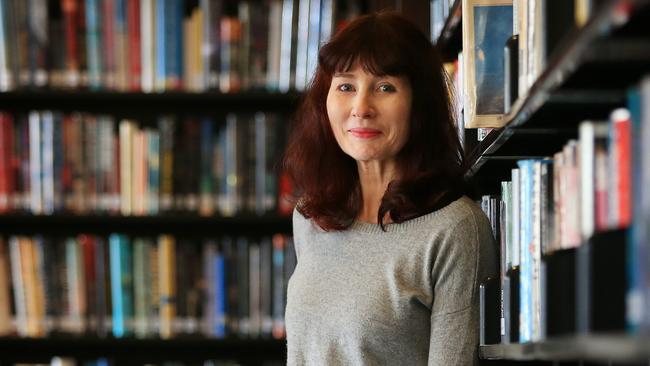Nabokov haunts Gail Jones’s A Guide to Berlin
Gail Jones’s new novel is set in modern-day Berlin but Russian writer Vladimir Nabokov haunts its every page.

Vladimir Nabokov had many jobs during his lean years as a Russian exile in interwar Berlin. He was a tennis coach, a tutor, a translator, a composer of chess puzzles and also, at one point in the early 1920s, an extra. The young author, who in those days wrote under the pseudonym Sirin, would catch a train to the suburbs and work for one of the many film production companies then operating in the Weimar equivalent of Hollywood.
Only a remarkable life could generate such interest in its minutiae, and Nabokov’s biography attaches to the reverential imagination of his admirers like filings to a magnet. Surely there are those who have scoured the background of films by Robert Wiene, FW Murnau or Fritz Lang — those masters of German cinematic expressionism whose efforts informed Sirin’s tyro novels and stories — hoping for a glimpse of that haughty genius swelling a crowd scene.
In A Guide to Berlin, Gail Jones has bent her considerable talents to capturing such evanescent traces. Her new novel might be set in present-day Berlin, but it is everywhere haunted by Nabokov’s ghost.
And fair enough: the author of Lolita was a great fan of spectral phenomena. His idiosyncratic belief system combined quantum entanglement with old-fashioned eidolism; he saw the divide between this world and the next as hopelessly permeable and he regarded everyday reality as encoded with messages from the other side, like an acrostic in a poem. Doubtless he would have applauded Jones’s elegant necromancy. But it is not wholly for him that she writes.
Because Nabokov is less the subject of A Guide to Berlin than its excuse. The narrative centres on a group of floating internationals — one American, two Italians, two Japanese and a lone Australian — who meet regularly in apartments around Berlin, ostensibly to discuss the great Russian but, as winter and the group’s bonds deepen, to talk of their own lives as well.
This darting cotillion of personal relations has at it centre a 20-something art school dropout named Cass. She spent her childhood in a remote Top End community, and she has carried that sense of melancholy isolation into adulthood. Adrift in Berlin, Cass reads and rides the U-Bahn, at times visiting sites of significance from Nabokov’s years in the city. It is outside an apartment where the author had once lived that the Australian meets Marco Gianelli, a fellow Nabokovian and member of the circle she will soon join.
Jones uses these meetings much as Christina Stead did in her first published book, The Salzburg Tales, to show off different facets of the same thematic and stylistic jewel. There is the older, verbose, avuncular Jewish-American scholar Victor, whose parents owned an umbrella-making factory in New Jersey after escaping from the war and its attendant darkness decades before. And there are Yukio and Mitsuko, fashionable bohemians who found love after Mistsuko was hired to provide therapy and support to Yukio, a teenage hikikomori sufferer who for years locked himself away from work, life, friends and study.
But it is to the Italians that Cass is most powerfully drawn. Marco is a literary scholar too, though one who has a real-estate rental business in Berlin to make ends meet. He’s serious and sweet, and in this sense very different from his old friend Gino, who is given to acerbic commentary and mysterious absences. Cass’s growing attraction to them violates the balanced communal spirit of the group and nudges the plot towards a sudden, violent culmination.
In the meantime, though, there is Nabokov: the dark matter that provides the remaining narrative mass. The group discusses everything from the novelist’s short stories (A Guide to Berlin is the title of one of them), his years of research into butterfly genitalia, his courageous homosexual brother Sergei, who went from being a pre-war playboy to an outspoken critic of the Nazi regime and was murdered by the state in 1945, to Nabokov’s love of hyper-specific and recondite words: meerschaum, drisk, ensellure, ophryon — the last of which refers to the invisible third eye, seat of migraine, epilepsy and inspiration.
And really, despite the characters’ superficially clever banter, it is that third eye that Jones is most interested in looking through. She sees a city rebuilt on top of thousands of unexploded bombs, in which Syrian refugees camp out in midwinter in their thousands. She sees a city where even the train stations seem to retain some complicity in the Holocaust, and where every other street is paved with ‘‘stumble stones’’, discrete plaques set into the ground memorialising some of the 160,000 Jews who once dwelled there. Berlin should properly be regarded as another character in the novel, so lovingly does Cass’s consciousness register its remnant glories, its contemporary maladies, its topographies of past terror:
Gradually the city was unfolding for her; she saw that she might know herself more subtly here, that the pressure of history, imposed like a spy mission, required her to develop a kind of inner sincerity. Small in the face of a terrible history, foreign, young, uncool, antipodean, she might find here an expression of her accumulated questioning. It was a challenge, she decided; there was a logic she must achieve, there were encryptions, there were passwords, there were possible solutions. Not only on the train system, but littered everywhere: signs and symbols, implications.
Signs and Symbols, as it happens, is the title of another short story by Nabokov, one that comes closest to addressing the total scandal of the totalitarian era in Europe. In it, the institutionalised son of elderly Russian-Jewish immigrants suffers from ‘‘referential mania’’, imagining that ‘‘everything that happens about him is a veiled reference to his personality and existence’’:
Phenomenal nature shadows him wherever he goes. Clouds in the staring sky transmit to one another, by means of slow signs, incredibly detailed information regarding him. His inmost thoughts are discussed at nightfall, in manual alphabet, by darkly gesticulating trees.
The remarkable thing about Signs and Symbols is that it can be read in two ways: from the parents’ perspective, it is a poignant and exquisitely modulated bit of literary realism; from the young man’s perspective, however, every sentence contains rhymes and references that flash like sirens. Form and content blend and ramify the substance of his despair.
What Jones has done in this cool and intricate novel is to expand the stylistic possibilities and exploit the metaphysical implications of Nabokov’s extraordinary story. She is not the first to do so — figures such as WG Sebald precede her — but a peculiar antipodean twist grants A Guide to Berlin its unique perspective. Hers is an unashamedly cerebral work that will only gain by rereading; but it is also, like its Nabokovian parent, a narrative that pulses with feeling. Its pages finally summon not one ghost but millions of them.
Geordie Williamson is The Australian’s chief literary critic.
A Guide to Berlin
By Gail Jones
Vintage, 272pp, $32.99




To join the conversation, please log in. Don't have an account? Register
Join the conversation, you are commenting as Logout